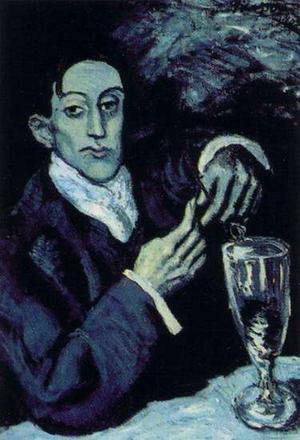Written by Michael Oudyn
Well, after our fine tasting and distillery tour (see last post) I couldn’t wait to start playing around with absinthe. It turns out I like it with less water and sugar than the usual. And with a lady jazz singer in the background. I’ve always had a taste for the bittersweet.
Between nips I’ve been doing a little research.
Absinthe was of course the drink of choice for the bohemian writers, artists, and poets of Parisian belle époque. For them muse extraordinaire absinthe stimulated the imagination with a “lucid drunkenness.” Unlike other alcoholic drinks it sharpened the mind, rather than dulling it; the herbs, especially wormwood, got the credit. Poet maudit Rimbaud combined it with hashish; Baudelaire ranked it even above opium and wine; Oscar Wilde described a sensation of having tulips brush against his legs while walking with an absinthe buzz. Frequent user Picasso painted its more mystical side, lucid side. Degas and notorious absinthe drinker Toulouse-Lautrec painted its darker side. A generation later Ernest Hemmingway joined other intellectuals in keeping the tradition alive.
Absinthe was always the target of social conservatives and prohibitionists possibly because of its association with immoral bohemian culture. Thujone, the alleged hallucinatory agent of wormwood, was the culprit. A Temperance Movement pamphlet proclaimed that “absinthe makes you crazy and criminal… provokes epilepsy and tuberculosis…has killed thousands of French people… makes a beast of man, a martyr of woman. “ In 1912, it was the first victim of America’s Prohibition movement.
But “misunderstood” absinthe has recently been cleared in the court of scientific experiment and is making a mild comeback in some artistic circles, although “more as an amusement than a muse.” It is now considered no more dangerous than other alcoholic drinks. Its “psychoactive properties,” so long vilified (or glorified), are now seen as exaggerated. Absinthe was legalized in Europe in the 1990’s, in America in 2007.
Wormwood, the muse/villain of our story, has in fact a long healthy past. The ancient Egyptians soaked it in wine and used it medicinally, as did the Greeks. (In fact the word absinthe comes from the Latin artemisia absinthium; absinthium from the ancient Greek name for wormwood, artemisia from Artemis, the Greek goddess of the hunt.) Nineteenth century French soldiers were given absinthe to prevent malaria while serving overseas. Some of them returned home with a great taste for the stuff which helped fuel the French absinthe boom . La fée verte “the green fairy” became so popular in Paris by the mid 19th century that five-o’clock aperitif time came to be known as l’heure verte, “the green hour.”
Our own personal “decadent goddess experience“ has also proved more “an amusement than a muse.” No green fairy sightings have been reported; nobody has felt Oscar Wilde’s mystical tulip brush against the legs or written decadent poetry in a lucid trance. Not yet anyway. Nobody is any crazier, inexplicably epileptic, or suddenly inclined to murder. Nobody has sunk into irredeemable stupor. Not yet anyhow.






October 10, 2014 at 5:01 pm |
Very cool post, Mike! I also have found the “ceremony” to be intriguing, but unfortunately, I’m too impatient to do it. I’ll stick with popping a cork and savoring my wine. ; )
October 23, 2014 at 3:17 pm |
I kind of agree with you! I love the whole lore and the absinthe gadget is cool to contemplate. But for every day, I too will just pop cork, or even twist cap.
October 22, 2014 at 5:52 pm |
very well done…of course…need your advice of some good brew for my upcoming seventieth birthday party…
October 23, 2014 at 3:12 pm |
Sure enough. They say that Hemingway, when he reached a certain age, was fond of absinthe mixed with champagne.